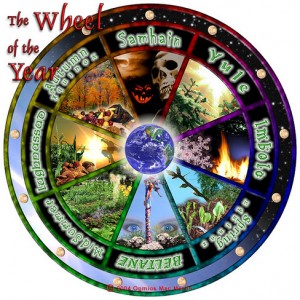Celebrated As The Natural Cycle Of The Seasons
We have a very special relationship with Mother Earth and celebrate Her turns of the wheel as Sabbats and Esbats. The Wheel of the Year marks the Sun’s journey across the sky, the solstices, equinoxes and the Earth’s changing seasons.
In some aspects of NeoPaganism (particularly Wicca), all of nature is seen as cyclical; the passing of time is a cycle, represented by a circle or wheel. The course of birth, life, decline, and death that we see in our human lives is echoed in the seasons.
Each stop of the wheel denotes an important moment of progression and change in the Earth.
The Wiccan religious calendar contains 13 Full Moon celebrations, or Esbats, and 8 Sabbats or days of power, 4 main Sabbats, 2 Equinoxes and 2 Solstices. The Sabbats honor the ground and are the festivals that make up the wheel of the year. They are also solar rituals, marking the points of the Sun’s yearly cycle, celebrating the passing of the year.
Mythically, each Sabbat also symbolizes a time in the life of the Wiccan God, who is born from the Wiccan Goddess, grows to full manhood, mates with her, and reigns as king during the summer. He then declines and dies, rising anew the next year. The eight Sabbats represent seasonal birth, death, and rebirth.
The Esbats honor the sky and focus on the Full Moon celebrations. There are 12-13 Full Moons yearly, or one every 28 1/4 days. The Moon is a symbol of the Goddess as well as a source of energy. Thus, after the religious aspects of the Esbats, we often practice magick, tapping into the larger amounts of energy which are thought to exist at these times. Most rites are held at night.
This calendar follows the seasons of the northern hemisphere, where the celebrations that form the basis of the modern Sabbats originated. Wiccans in the southern hemisphere usually celebrate the Sabbats on the opposite dates of the year (6 months apart from the northern dates), in order to follow the cycle of seasons where they live; i.e. an Australian Neopagan would celebrate Samhain on May 1, when a Canadian Neopagan would be celebrating Beltane.
HISTORY OF THE WHEEL
The four cross-quarter festivals (often called ‘fire festivals’) of Imbolc, Beltaine, Lughnasadh and Samhain are historically authentic and well attested in medieval Ireland; they probably derive from the first century Coligny Calendar which, being a lunisolar calendar (a calendar whose date indicates both the moon phase and the time of the solar year), does not correspond to fixed days in the solar calendar.
Modern Interpretations of The Wheel
Some Wiccans are adopting dates for the Cross-Quarter Sabbats, between the Equinoxes and Solstices, based on a count of days rather than the calends of the months, working on the assumption that the dates given above derive from the Roman based Gregorian Calendar. They recognize that the fire festivals are near the midpoints between the solstices and equinoxes, and use the midpoint dates instead of the traditional dates. These modern calculations tend to give dates a few days after the traditional calendar based dates. Others, who cite origins of the fire festivals in the Celtic calendar, dispute this practice as anachronistic and based on faulty logic.
Sabbats
Midwinter/Yule, on the winter solstice
Imbolc, on February 2 and the preceding eve
Ostara, on the spring equinox
Beltane/Beltaine/May Day on May 1 and the preceding eve
Midsummer/Litha, on the summer solstice
Lughnasadh/Lammas, on August 1 and the preceding eve
Mabon, on the autumnal equinox
Samhain, on November 1 and the preceding eve October 31
Esbats


